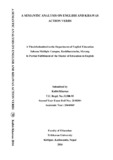Please use this identifier to cite or link to this item:
https://elibrary.tucl.edu.np/handle/123456789/1484Full metadata record
| DC Field | Value | Language |
|---|---|---|
| dc.contributor.author | Khawas, Kulbir | |
| dc.date.accessioned | 2018-04-18T04:48:58Z | |
| dc.date.accessioned | 2021-07-23T02:43:06Z | - |
| dc.date.available | 2018-04-18T04:48:58Z | |
| dc.date.available | 2021-07-23T02:43:06Z | - |
| dc.date.issued | 2016 | |
| dc.identifier.uri | http://elibrary.tucl.edu.np/handle/123456789/1484 | - |
| dc.description.abstract | The present study entitled "A Semantic Analysis on English and Khawas Action Verbs" has been carried out in order to find out the similarities and differences between English and Khawas action verbs. The study also suggests some pedagogical implications which will be useful while teaching the action verbs of English to the Khawas speaking students and vice-versa. The researcher used both primary and secondary data to complete the study. The native speakers of Khawas language in Koshiharaincha municipality and Dangihat, Dangraha and Tankisinuwari VDCs of Morang district were theprimarysources of data and different books, journals, magazines were the secondary sources of data. The researcher used the judgmental sampling procedure to sample the population. The sample population was 50 native speakers of Khawas language. A set of questionnaire was given to the sample population to write the equivalent Khawas action verbs the English action verbs. After collecting the responses the verbs were tabulated and compared. Again, the detailed analysis of the native speakers'response was made and findings and conclusion were accordingly presented. The analysis and interpretation of the data has been done descriptively. The major finding of this study is the Khawas action verb khyā(eat) has a very extensive range of meaning in English which is used to refer to taking all solid, liquid and sometimes even gas forms of the food, drinks , air or smoke. This report consists of five chapters .Chapter one deals with the background of the study, statement of the problem, objectives of the study, significance of the study, delimitations of the study and operational definition of the key terms. Chapter two consists of review of theoretical literature, review of empirical literature, implications of the review for the study and conceptual frame work. Chapter three consists of the design and method of the study, population, sample and sampling strategy, data collection tools and techniques and data collection procedures. Chapter four deals with the analysis of data, interpretation of the results and summary of findings. Chapter five is about the conclusions and recommendations made on the basis of the findings of the study. Besides main chapter, the supportive materials such as references, questionnaire, tables, charts, etc. that are used during the research are presented in the appendices of the thesis. | en_US |
| dc.language.iso | en_US | en_US |
| dc.publisher | Faculty of Education Tribhuvan University Kirtipur, Kathmandu, Nepal | en_US |
| dc.subject | English Language | en_US |
| dc.subject | Linguistics | en_US |
| dc.subject | Endo-Europeans | en_US |
| dc.title | A Semantic Analysis on English and Khawas Action Verbs | en_US |
| dc.type | Thesis | en_US |
| Appears in Collections: | English Language Education | |
Items in DSpace are protected by copyright, with all rights reserved, unless otherwise indicated.

